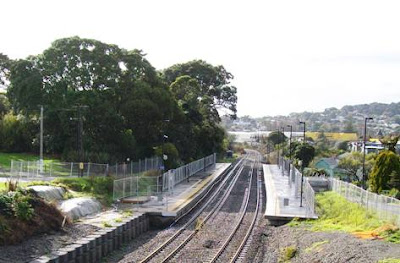Farewell, Tait-Trent Street Station, you have served us well.
On Sunday the 13th, with no trains on the Western Line, the entrances/exits to the two temporary platforms were removed. Soon, the platforms will disappear as well.
But the new station is quite cool. Sure, Crayford Street East is a bit of a climb when coming home from out of the city, but -- it has always been a climb. I guess the old road has become our new Station Hill. You can hardly call Rosebank Road leading up to Blockhouse Bay Road that anymore. And so, our history changes. That's Layard Street, stretching off to the right.
The platforms were still shut off on Sunday, so I ducked around via St Judes Street on my way up the hill. Was invited in for a coffee by Rev Bob Hornburg of St Judes, so had a cuppa and a bikkie with St Judes parishioners in the old hall there. Such mornings like that one -- is just one of the reasons why I love my home suburb of Avondale. (The reverend was in his flowing green robes at the time, the morning service having just come to an end, and I can still see him standing on the steps of the church, arms stretched, out making the invitation. It was almost like I'd come across a country church, all of a sudden ...)
Come Monday morning, and the new station is operational. This is a shot from the westbound platform (In was headed to Henderson and Mill Cottage) of the eastbound platform. Met up with another long-time Avondale resident who said the only thing amiss was that there was no nearby purpose-built carparking. He was right -- ARTA and Auckland City have yet to come to some agreement as to what and where they'll have as a parking area (park n' ride, or kiss n' ride).



















































